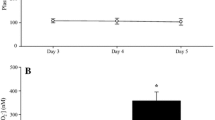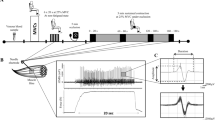Abstract
Dietary nitrate supplementation, which enhances nitric oxide (NO) bioavailability, has previously been shown to contribute to improved exercise performance by reducing both oxygen cost and energy expenditure. In contrast, previous studies have indicated that NO can lower force production in vitro. To examine the role of dietary nitrates in regulating force generation under normal physiological conditions, we undertook an extended nitrate supplementation regime and determined force output and energy cost with a repeated isometric maximum voluntary contraction (MVC) protocol. In a double-blind, randomized, crossover design, eight participants received 0.5 l/day of nitrate-rich (BR) or nitrate-depleted (PL) beetroot juice for 15 days and completed an exercise protocol consisting of 50 MVCs at 2.5 h, 5 days and 15 days after the beginning of the supplementation period. No significant reduction in force output was determined for BR relative to PL for the peak contraction, the mean or the end force, and no significant time effect was found over the course of the supplementation period. There was a reduction in the mean PCr cost of exercise averaged over the BR supplementation trials, but this did not reach statistical significance for end exercise (BR 15.10 ± 4.14 mM, PL 17.10 ± 5.34 mM, P = 0.06) or the mean throughout the protocol (BR 15.96 ± 4.14 mM, PL 17.79 ± 4.51 mM, P = 0.06). However, a significant reduction in PCr cost per unit force output was found for BR at end exercise (P = 0.04). These results indicate that, under normal physiological conditions, increased NO bioavailability is not associated with a reduction of force-generating capability in human skeletal muscle and confirm that nitrate supplementation reduces the PCr cost of force production.





Similar content being viewed by others
References
Aghadasi B, Reid MB, Hamilton SL (1997) Nitric oxide protects the skeletal muscle Ca2+ release channel from oxidation induced activation. J Biol Chem 272:25462–25467
Albertini M, Lafortuna C, Aguggini G (1997) Effects of nitric oxide on diaphragmatic muscle endurance and strength in pigs. Exp Physiol 82:99–106
Ameredes BT, Provenzano MA (1999) Influence of nitric oxide on vascular resistance and muscle mechanics during titanic contractions in situ. J Appl Physiol 87:142–151
Andrade FHMR, Reid MB, Allen DG, Westerblad H (1998) Effect of nitric oxide on single skeletal muscle fibres from the mouse. J Physiol 509:577–586
Andrade FHMR, Reid MB, Westerblad H (2001) Contractile response of skeletal muscle to low peroxide concentrations: myofibrillar calcium sensitivity as a likely target for redox-modulation. FASEB J 15:309–311
Bailey SJ, Fulford J, Vanhatalo A, Winyard PG, Blackwell JR, DiMenna FJ, Wilkerson DP, Benjamin N, Jones AM (2010) Dietary nitrate supplementation enhances muscle contractile efficiency during knee-extensor exercise in humans. J Appl Physiol 109:135–148
Bailey SJ, Winyard P, Vanhatalo A, Blackwell JR, DiMenna FJ, Wilkerson DP, Benjamin N, Jones AM (2009) Dietary nitrate supplementation reduces the O2 cost of low-intensity exercise and enhances tolerance to high-intensity exercise in humans. J Appl Physiol 107:1144–1155
Bateman RM, Ellis CG, Freeman DJ (2002) Optimization of nitric oxide chemiluminescence operating conditions for measurement of plasma nitrite and nitrate. Clin Chem 48:570–573
Bisnett T, Anzueto A, Andrade FH, Rodney GG Jr, Napier WR, Levine SM, Maxwell LC, Mureeba P, Derdak SD, Grisham MB, Jenkinson SG (1998) Effect of nitric acid synthase inhibitor on diaphragmatic function after resistive loading. Comp Biochem Physiol 119A:185–190
Brotto MAP, Nosek TM (1996) Hydrogen peroxide disrupts calcium release from the sarcoplasmic reticulum of rat skeletal muscle fibres. J Appl Physiol 81:731–737
Cermak NM, Gibala MJ, van Loon LJ (2012) Nitrate supplementation’s improvement of 10-km time-trial performance in trained cyclists. Int J Sport Nutr Exerc Metab 22:64–71
Clementi E, Nisoli E (2005) Nitric oxide and mitochondrial biogenesis: a key to long-term regulation of cellular metabolism. Comp Biochem Physiol 142:102–110
Cosby K, Partovi KS, Crawford JH, Patel RP, Reiter CD, Martyr S, Yang BK, Waclawiw MA, Zalos G, Xu X, Huang KT, Shields H, Kim-Shapiro DB, Schechter AN, Cannon RO 3rd, Gladwin MT (2003) Nitrate reduction to nitric oxide by deoxyhemoglobin vasodilates the human circulation. Nat Med 9:1498–1505
Evangelista AM, Rao VS, Filo AR, Marozkina NV, Doctor A, Jones DR, Gaston B, Guilford WH (2010) Direct regulation of striated muscle myosins by nitric oxide and endogenous nitrosothiols. PLoS One 5:e11209
Ferguson SK, Hirai DM, Copp SW, Holdsworth CT, Allen JA, Jones AM, Musch TI, Poole DC (2012) Impact of dietary nitrate supplementation via beetroot juice on exercising muscle vascular control in rats. J Physiol. doi:10.1113/jphysiol.2012.243121
Folland JP, Maas H, Jones DA (2000) The influence of nitric oxide on in vivo human skeletal muscle properties. Acta Physiol Scand 169:141–148
Galler S, Hilber K, Gobesberger A (1997) Effects of nitric oxide on force-generating proteins of skeletal muscle. Pfleugers Arch 434:242–245
Govoni M, Jansson EA, Weitzberg E, Lundberg JO (2008) The increase in plasma nitrite after a dietary nitrate load is markedly attenuated by an antibacterial mouthwash. Nitric Oxide 19:333–337
Haycock JW, Jones P, Harris JB, Mantle D (1996) Differential susceptibility of human skeletal muscle proteins to free radical induced oxidative damage: a histochemical, immunocytochemical and electron microscopical study in vitro. Acta Neuropathol 92:331–340
Heunks LMA, Cody MJ, Geiger PC, Dekhuijzen PNR, Sieck GC (2001) Nitric oxide impairs Ca2+ activation and slows cross-bridge cycling kinetics in skeletal muscle. J Appl Physiol 91:2233–2239
Hirschfield W, Moody MR, O’Brien WE, Gregg AR, Bryan RM Jr, Reid MB (2000) Nitric oxide release and contractile properties of skeletal muscle from mice deficient in type III NOS. Am J Physiol 278:R95–R100
Ignarro LJ (1989) Endothelium-derived nitric oxide: actions and properties. FASEB 3:31–36
Jansson EA, Huang L, Malkey R, Govoni M, Nihlén C, Olsson A, Stensdotter M, Petersson J, Holm L, Weitzberg E, Lundberg JO (2008) A mammalian functional nitrate reductase that regulates nitrite and nitric oxide homeostasis. Nat Chem Biol 4:411–417
Jubrias SA, Crowther GJ, Shankland EG, Gronka RK, Conley KE (2003) Acidosis inhibits oxidative phosphorylation in contracting human skeletal muscle in vivo. J Physiol 553:589–599
Kemp GJ, Meyerspeer M, Moser E (2007) Absolute quantification of phosphorus metabolite concentrations in human muscle in vivo by 31P MRS: a quantitative review. NMR Biomed 20:555–565
Kemp GJ, Taylor DJ, Radda GK (1993) Control of phosphocreatine resynthesis during recovery from exercise in human skeletal muscle. NMR Biomed 6:66–72
Kobzik L, Reid MB, Bredt DS, Stamler JS (1994) Nitric oxide in skeletal muscle. Nature 372:546–548
Larsen FL, Schiffer TA, Borniquel S, Sahlin K, Ekblom B, Lundberg JO, Weitzberg E (2011) Dietary inorganic nitrate improves mitochondrial efficiency in humans. Cell Metab 13:149–159
Larsen FL, Weitzberg E, Lundberg JO, Ekblom B (2007) Effects of dietary nitrate on oxygen cost during exercise. Acta Physiol 191:59–66
Larsen FL, Weitzberg E, Lundberg JO, Ekblom B (2010) Dietary nitrate reduces maximal oxygen consumption while maintaining work performance in maximal exercise. Free Radic Biol Med 48:342–347
Maréchal G, Gailly P (1999) Effects of nitric oxide on the contraction of skeletal muscle. Cell Mol Life Sci 55:1088–1102
Meszaros LG, Minarovic I, Zahradnikova A (1996) Inhibition of the skeletal muscle ryanodine receptor calcium release channel by nitric oxide. FEBS Lett 380:49–52
Minneci PC, Deans KJ, Shiva S, Zhi H, Banks SM, Kern S, Natanson C, Solomon SB, Gladwin MT (2008) Nitrite reductase activity of haemoglobin as a systemic nitric oxide generator mechanism to detoxify plasma haemoglobin produced during hemolysis. Am J Physiol Heart Circ Physiol 295:H743–H754
Modin A, Bjorne H, Herulf M, Alving K, Weitzberg E, Lundberg JO (2001) Nitrate-derived nitric oxide: a possible mediator of ‘acidic-metabolic’ vasodilation. Acta Physiol Scand 171:9–16
Moopaner TR, Allen DG (2005) Reactive oxygen species reduce myofibrillar Ca2+ sensitivity in fatiguing mouse skeletal muscle at 37 degrees C. J Physiol 564:189–199
Murrant CL, Frisbee JC, Barclay JK (1997) The effect of nitric oxide and endothelin on skeletal muscle contractility changes when stimulation is altered. Can J Physiol Pharmacol 75:414–422
Nisoli E, Clementi E, Paolucci C, Cozzi V, Tonello C, Sciorati C, Bracale R, Valerio A, Francolini M, Moncada S, Carruba MO (2003) Mitochondrial biogenesis in mammals: the role of endogenous nitric oxide. Science 299:896–899
Nisoli E, Falcone S, Tonello C, Cozzi V, Palomba L, Fiorani M, Pisconti A, Brunelli S, Cardile A, Francolini M, Cantoni O, Carruba MO, Moncada S, Clementi E (2004) Mitochondrial biogenesis by NO yields functionality active mitochondria in mammals. Proc Natl Acad Sci USA 101:16507–16512
Perkins WJ, Han Y-S, Sieck GC (1997) Skeletal muscle force and actomyosin ATPase activity reduced by nitric oxide donor. J Appl Physiol 83:1326–1332
Powers SP, Jackson MJ (2008) Exercise-induced oxidative stress: cellular mechanisms and impact on muscle force production. Physiol Rev 88:1243–1276
Reid MB (1998) Role of nitric oxide in skeletal muscle: synthesis, distribution, and functional importance. Acta Physiol Scand 162:401–409
Reid MB (2001) Nitric oxide, reactive oxygen species, and skeletal muscle contraction. Med Sci Sports Exerc 33:371–376
Reid MB (2001) Redox modulation of skeletal muscle contraction: what we know and what we don’t. J Appl Physiol 90:724–731
Shiva S (2010) Mitochondria as metabolizers and targets of nitrite. Nitric Oxide 15:64–74
Spiegelhalder B, Eisenbrand G, Preussmann R (1976) Influence of dietary nitrate on nitrite content of human saliva: possible relevance to in vivo formation of N-nitroso compounds. Food Cosmet Toxicol 14:545–548
Stoyanovsky DA, Murphy TD, Anno PR, Kim YM, Salama G (1997) Nitric oxide activates skeletal and cardiac ryanodine receptors. Cell Calcium 21:19–29
Taylor DJ, Bore PJ, Styles P, Gadian DG, Radda GK (1983) Bioenergetics of intact human muscle. A 31P nuclear magnetic resonance study. Mol Biol Med 1:77–94
Taylor DJ, Styles P, Matthews PM, Arnold DA, Gadian DG, Bore P, Radda GK (1986) Energetics of human muscle: exercise-induced ATP depletion. Magn Reson Med 3:44–54
van den Broek NMA, De Feyter HMML, Graaf LD, Nicolay K, Prompers JJ (2007) Intersubject differences in the effect of acidosis on phosphocreatine recovery kinetics in muscle after exercise are due to differences in proton efflux rates. Am J Physiol 293:C228–C237
Vanhamme L, van den Boogaart A, Van Huffel S (1997) Improved method for accurate and efficient quantification of MRS data with use of prior knowledge. J Magn Reson 129:35–43
Vanhatalo A, Bailey SJ, Blackwell JR, DiMenna FJ, Pavey TG, Wilkerson DP, Benjamin N, Winyard PG, Jones AM (2010) Acute and chronic effects of dietary nitrate supplementation on blood pressure and the physiological responses to moderate-intensity and incremental exercise. Am J Physiol Regul Integr Comp Physiol 299:R1121–R1131
Vanhatalo A, Fulford J, Bailey SJ, Blackwell JR, Winyard PG, Jones AM (2011) Dietary nitrate reduces muscle metabolic perturbation and improves exercise tolerance in hypoxia. J Physiol 589:5517–5528
Zhang Z, Naughton D, Winyard PG, Benjamin N, Blake DR, Symons MCR (1998) Generation of nitric oxide by a nitrite reductase activity of xanthine oxidase: a potential pathway for nitric oxide formation in the absence of nitric oxide synthase activity. Biochem Biophys Res Commun 249:767–772
Author information
Authors and Affiliations
Corresponding author
Additional information
Physiological relevance: these results indicate that, under normal physiological conditions, dietary nitrate supplementation is not associated with a reduction of force-generating capability in human skeletal muscle but reduces the PCr cost of force production.
Rights and permissions
About this article
Cite this article
Fulford, J., Winyard, P.G., Vanhatalo, A. et al. Influence of dietary nitrate supplementation on human skeletal muscle metabolism and force production during maximum voluntary contractions. Pflugers Arch - Eur J Physiol 465, 517–528 (2013). https://doi.org/10.1007/s00424-013-1220-5
Received:
Revised:
Accepted:
Published:
Issue Date:
DOI: https://doi.org/10.1007/s00424-013-1220-5




